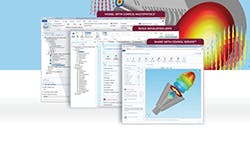Comsol releases MultiphysicsR version 5.2 providing a fully integrated environment for creating simulation apps. Major upgrades to the Application Builder available in Comsol Multiphysics include the new Editor Tools for creation of user interface components, commands for dynamic updates of graphics and more control over the deployment of simulation apps. Running simulation apps using Comsol Server in a corporate network or in the cloud is now up to five times faster, according to the company.
Highlights of new features and tools available in Version 5.2 include:
- Comsol MultiphysicsR, Application Builder, and Comsol ServerT: Streamlined workflow in the Application Builder with Editor Tools for bringing any model parameter, physics setting, and results such as numerical data and plots into the user interface of an app. Enhancements to user experience with the customization of graphic toolbar buttons, plot while solving, dynamics updates of graphics and improved copy-paste between applications. A more powerful Comsol ServerT with the ability to reconnect to running applications and launch of single dedicated applications upon login. License management with better handling of lost connection and licenses released during a session.
- Geometry and Mesh: Mesh Parts to import surface and volume meshes for use in geometry building. More robust tetrahedral meshing. An additional geometry operation, Partition Domains, to extend the reach of hexahedral meshing.
- Mathematical Modeling Tools, Studies and Visualization: Annotations for displaying customized texts and results in 2D and 3D plots. Users can choose to store only a selected part of the solution for post-processing purposes. Pardiso solver for clusters. Improved FFT studies. Residual operator that can be used to plot the residual in each point in space to get an intuitive visualization of where the error is largest.
- Apps: More than 50 app examples for electrical, mechanical, fluid and chemical simulations.
- Multipurpose: The Particle Tracing Module supports model particle-matter interactions for simulating high-energy physics and powerful particle counters for counting the number of particles in domains and on boundaries.
- Electrical: The AC/DC Module features an effective nonlinear constitutive relations formulation for approximating nonlinear magnetic materials in the frequency domain. Shared library files can be used to create magnetic materials that include hysteresis and irreversible effects. Smith plots are available in the RF Module.
- Fluid: Laminar three-phase flow multiphysics interface in the CFD Module based on the phase-field method. More turbulence support for rotating machinery and a free surface tool for frozen rotor studies. With the Pipe Flow Module users can model compressible flow in pipes and expansion and contractions due to sudden changes in the cross-section area of the pipes.
- Chemical: The Chemical Reaction Engineering Module allows catalytic particles of different particle shapes (spheres, cylinders, flakes and user defined based on area and volume). The Corrosion Module supports the modeling of thin beam structures.
- Mechanical: Shared library files can be used to create nonlinear structural materials. Contact improvements in the Structural Mechanics Module for curved surfaces and small relative displacements. The Heat Transfer Module has a symmetry plane for surface-to-surface radiation and external temperatures for thin layers. The Acoustics Module includes octave and 1/3rd octave plots.





